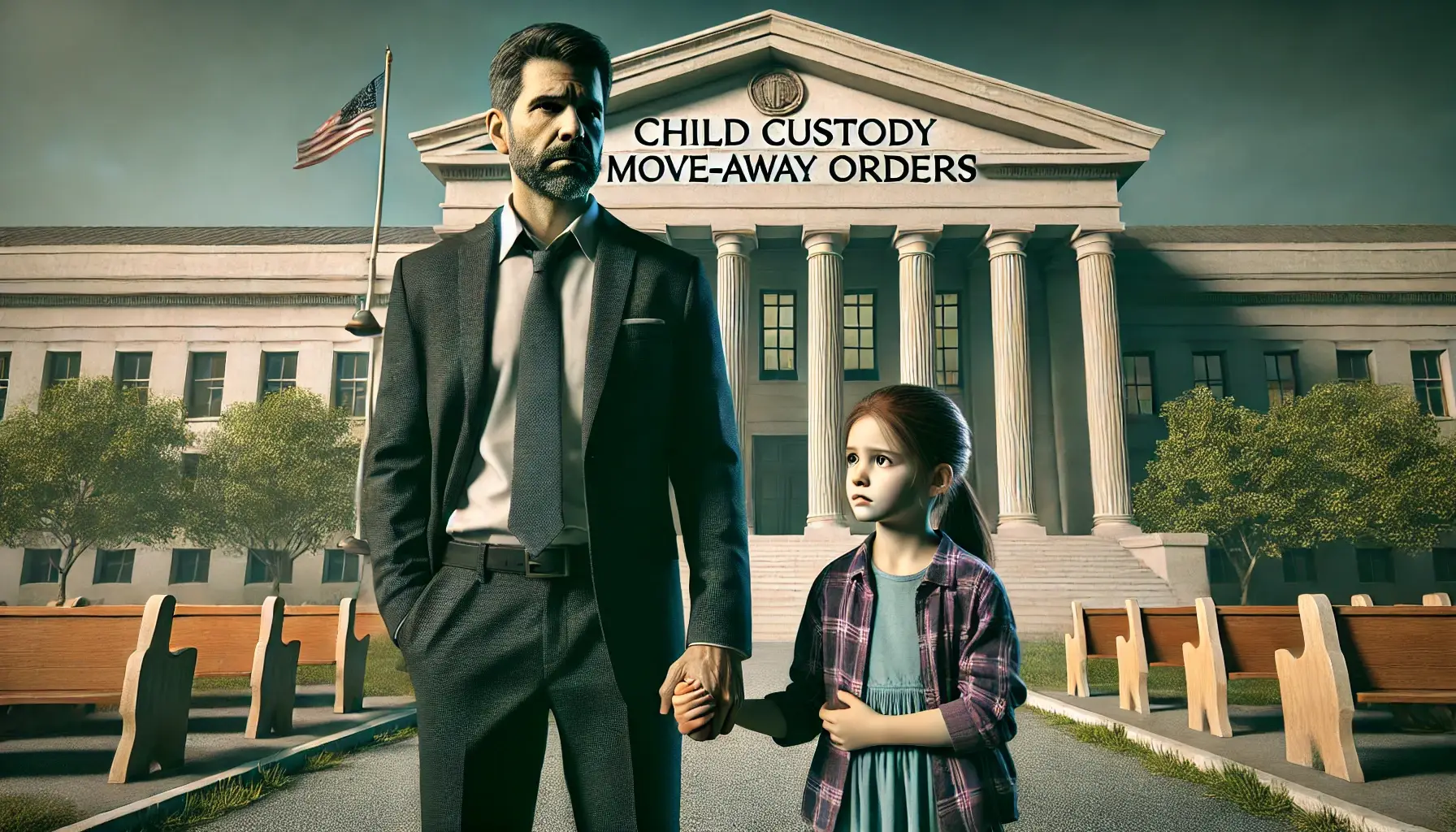Can I Get A Move-Away Order In California?
When we talk about family, we know that sometimes the hardest decisions come from a place of deep love and concern. Relocating with your child after a divorce or custody agreement ranks among the most challenging journeys a parent can face. I recently encountered a story on AVVO that touched my heart – a father worried about his 10-year-old daughter living part-time with her mother in what amounts to a converted shed with inadequate facilities. This father dreams of moving beyond California’s borders to create a safer, more nurturing home for his little girl, but faces resistance from her mother. He wanted to know if he could get a move-away order in California
In my years of advocacy for families and children, I’ve seen how these difficult crossroads require both compassion and clear-headed determination. Let me share with you the pathways available when you’re seeking what’s truly best for your child.
Key Take Aways
- Best Interests Standard: Courts prioritize children’s wellbeing over all other factors when deciding move-away cases in California.
- Current Custody Matters: Parents with primary physical custody face fewer hurdles when requesting move-away orders in California.
- Documentation Is Critical: Thoroughly document poor living conditions, economic instability, and communication restrictions to strengthen your case.
- Visitation Plans Required: Create a detailed post-relocation visitation schedule showing your commitment to maintaining the other parent-child relationship.
- Professional Help Needed: Complex move-away cases benefit from experienced family law attorneys who understand California’s specific requirements.
The Heart of Move-Away Orders In California
We all know that family courts care deeply about one thing above all else – our children’s wellbeing. A move-away order in California reflects this priority by carefully weighing how relocation affects a child’s whole life. When I think about these decisions, I’m reminded that they touch every aspect of childhood development.
Your existing custody arrangement matters tremendously in this process. Those of you already serving as primary caregivers start from firmer ground. Courts recognize the stability you provide every day. The father in our example cares for his daughter most days, with the mother having Tuesday and Thursday evenings plus alternate weekends. This foundation strengthens his case considerably.
When judges evaluate these requests, they look at the whole picture of a child’s life. They consider how far you plan to move and whether meaningful relationships can continue despite distance. Most importantly, they ask whether this change truly lifts up your child. Will they have better educational opportunities? Will their health and safety improve? Will they find greater emotional support? These questions cut to the heart of what matters.
Grounds for Requesting a Move-Away Order
In my work with families throughout the years, I’ve seen how inadequate living conditions can profoundly impact a child’s sense of security and self-worth. No child should live without proper shelter, heating, plumbing, or other basic necessities. When these fundamental needs go unmet, as in the case of our father’s daughter in this AVVO case, the courts take notice. These circumstances provide compelling grounds for considering relocation.
Economic instability creates another serious concern. Imagine a 10-year-old needing to ask for money to buy food – this reveals a deeply troubling situation that no child should face. Our children deserve reliable access to nutrition and life’s basic necessities. When they don’t receive these essentials, courts rightly question whether the current arrangement truly serves their needs.
Equally important is healthy communication between parents and children. When one parent prevents a child from reaching out to the other, they create barriers to essential emotional connections. Our children need the freedom to maintain loving relationships with both parents. Restrictions on these bonds rarely serve a child’s best interests.
When considering your move, focus on how it directly addresses your child’s needs. Perhaps you’ve found better schools in your new location, or secured stable housing that provides the space and safety your child deserves. Maybe you’ve located employment that offers financial security and better healthcare benefits. These concrete improvements demonstrate how your move genuinely uplifts your child’s life journey.
Custody Modification as an Alternative
Sometimes a complete custody modification offers a more appropriate solution than a move-away order in California. This approach works particularly well when significant welfare concerns exist. A modification request can address both the custody arrangement and the proposed relocation simultaneously.
The process begins with filing a Request for Order with the family court. This document should detail all relevant concerns about the current living situation. Include specific examples of inadequate housing, economic instability, or communication restrictions. Then outline your proposed solution, including the benefits of your new location.
Evidence plays a crucial role in custody modification cases. Document everything thoroughly and systematically. Keep records of conversations with your child about living conditions. Save text messages or emails that demonstrate concerns or uncooperative behavior. When legally appropriate, photographs of inadequate living conditions may prove valuable.
Expert opinions can significantly strengthen your modification request. Consider consulting with professionals who can evaluate your child’s current situation. Family therapists, education specialists, or housing experts may provide valuable insights. Their objective assessments carry substantial weight with family court judges.
The Protective Role of Child Services
When concerns about a child’s safety or basic needs rise to a certain level, Child Protective Services may need to become involved. This step should never be taken lightly, but when genuine welfare issues exist, these professionals can provide crucial intervention and assessment.
If you find yourself needing to request a CPS welfare check, focus exclusively on specific conditions that affect your child’s health and safety. Describe inadequate shelter, lack of proper facilities, or nutritional concerns with factual precision. Remember that this process isn’t about criticizing the other parent but about ensuring your child’s fundamental needs receive proper attention.
CPS evaluations look at several critical factors – whether your child has adequate shelter, sufficient food, necessary medical care, and a safe overall environment. They also consider emotional wellbeing and whether essential developmental needs are being met. Their assessment provides an independent professional perspective that courts value highly when making custody determinations.
Should CPS confirm concerns about living conditions, their reports can substantiate your request for relocation. This objective evidence often proves decisive in complex custody matters where competing narratives make it difficult for courts to determine the full reality of a child’s situation.

Building Bridges: Creating a Visitation Plan That Works
One of the values I’ve always held dear is that children need meaningful relationships with both parents whenever possible. Courts share this perspective and look favorably on parents who actively support these connections despite geographical distance. A thoughtful visitation plan demonstrates your commitment to co-parenting even as you pursue necessary changes.
Begin by creating a clear schedule for in-person visits. Consider offering extended time during summer and school breaks to balance the reduced frequency of weekend visits. Think realistically about travel costs and indicate your willingness to share these expenses fairly. These practical considerations show your good faith effort to maintain important family bonds.
Technology now offers wonderful opportunities for staying connected across distances. Include regular video calls in your visitation plan, specifying days and times to establish consistency. Think about how your child might share school achievements, art projects, and daily experiences virtually. These touchpoints maintain emotional closeness between visits.
Special occasions deserve particular attention in your planning. Address how birthdays, graduations, and holidays will be handled with sensitivity and fairness. Your flexibility around important life moments demonstrates the generosity of spirit that courts value when evaluating move-away requests.
The father in our example should emphasize his commitment to nurturing his daughter’s relationship with her mother, even as he seeks a safer environment. This balanced approach acknowledges that both parents matter deeply in a child’s emotional landscape.
Moving Forward With Purpose and Determination
If you’re contemplating a move-away request, begin by finding a qualified family law attorney who specializes in these complex cases. The right legal guidance makes an enormous difference in navigating California’s family court system. An experienced attorney helps develop a strategic approach tailored to your unique circumstances.
While building your case, gather comprehensive documentation that tells your child’s story truthfully. Keep detailed records of conditions, conversations, and concerns. Save communications that illustrate the situation clearly. When legally appropriate, document physical conditions through photographs or videos. These elements establish the factual foundation that supports your request.
Consider exploring mediation before proceeding to court. California generally requires this step in custody disputes, and sometimes it produces mutually acceptable solutions without adversarial proceedings. Even partial agreements reduce conflict and demonstrate your commitment to collaborative problem-solving whenever possible.
Throughout this challenging journey, maintain unwavering focus on your child’s needs rather than your own preferences. Present specific examples of how relocation will enhance their education, emotional development, physical wellbeing, and overall quality of life. This child-centered perspective aligns perfectly with the court’s primary consideration: the best interests of your child.
Conclusion
The path toward a move-away order in California requires patience, preparation, and a genuine commitment to your child’s wellbeing. By focusing consistently on how relocation serves their best interests, documenting concerning conditions thoroughly, and demonstrating your dedication to co-parenting despite distance, you create the strongest possible case for court approval.
Remember that each family’s situation contains unique elements, and outcomes depend on many factors. Professional legal guidance proves invaluable when navigating these complex waters. With proper preparation and representation, you can advocate effectively for arrangements that truly nurture your child’s growth and potential.
Our children deserve environments where they can thrive – physically, emotionally, and intellectually. When current arrangements fall short of this standard, we must sometimes make difficult choices to secure their wellbeing. By approaching these challenges with both determination and empathy, we honor our highest calling as parents: creating safe, loving spaces where our children can become their best selves.
Considering a Move-Away Custody Decision?
You’re not alone. Navigating these complex decisions can feel overwhelming—but help is available. Download my FREE guide: “5 Essential Steps to Successfully Navigate a Move-Away Request.” Empower yourself with the knowledge to advocate confidently for your child’s future.
FAQ's
What factors do California courts consider most important in move-away cases?
Can I still get a move-away order if I don't have primary physical custody?
How do I document poor living conditions at my ex's home?
Will the court consider my child's preference about moving?
How long does the move-away order process typically take?

About Esther
Esther C. Moore is a family law attorney with over 27 years of experience, including high-conflict child custody and divorce cases. As the CEO of All Rise Solutions, LLC, Esther provides coaching, online courses, and resources to help individuals navigate the legal system when dealing with complex family law matters. With a deep understanding of how narcissistic dynamics impact custody and divorce proceedings, Esther is committed to empowering individuals with the knowledge and tools they need to protect their rights.






